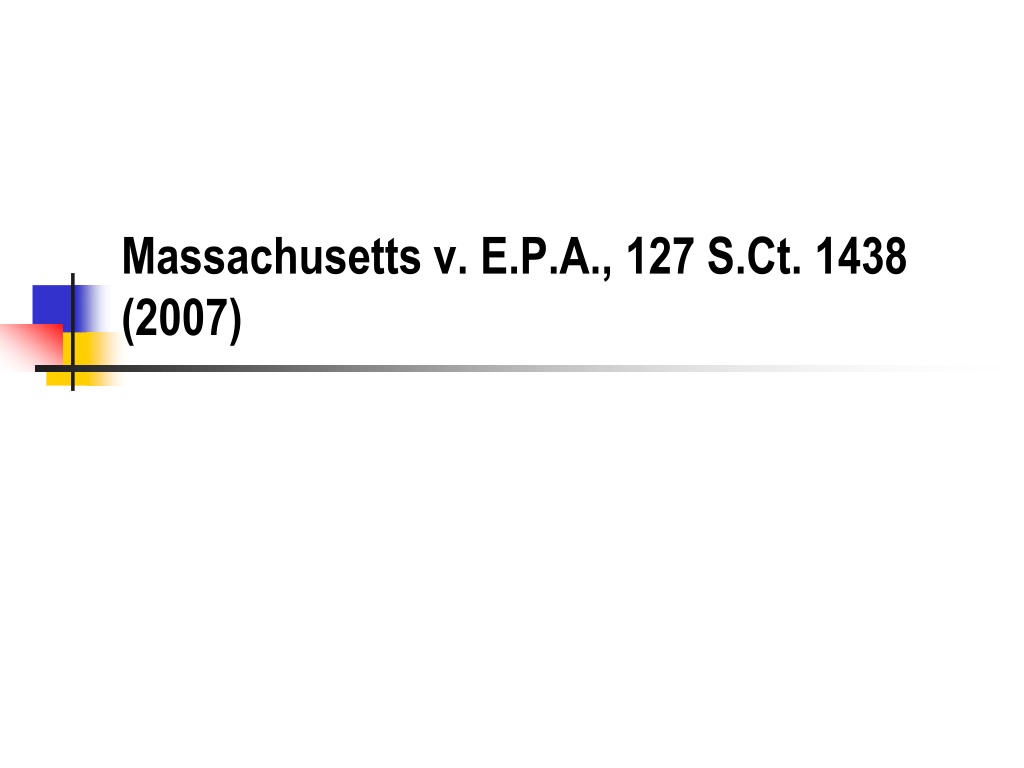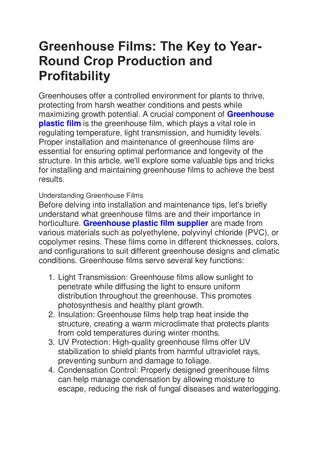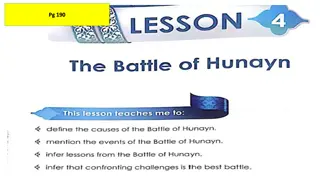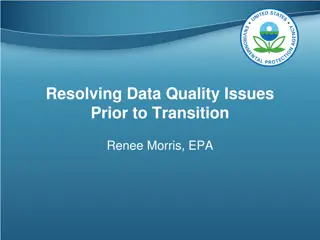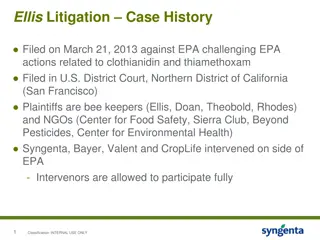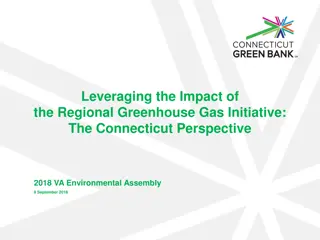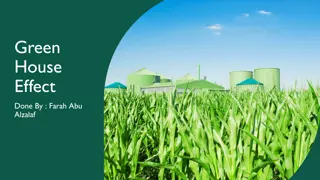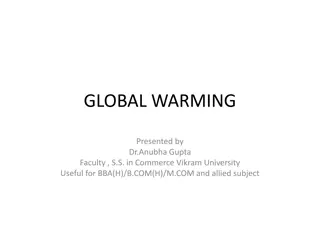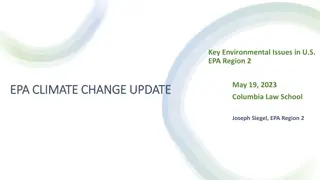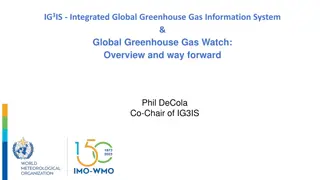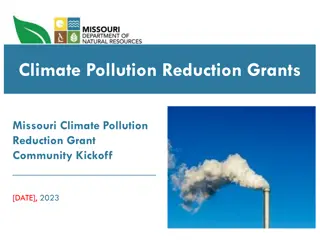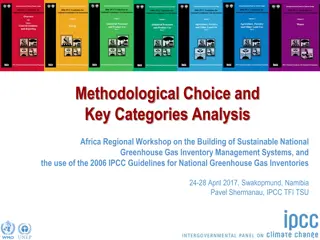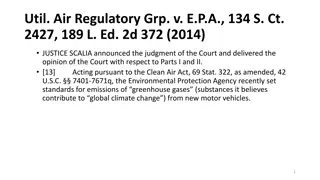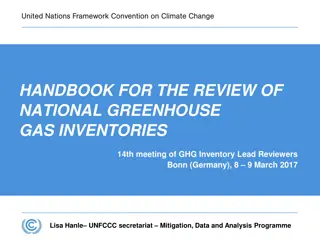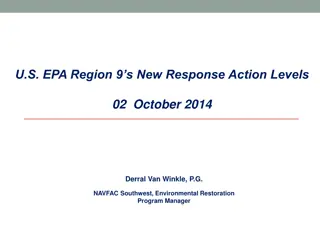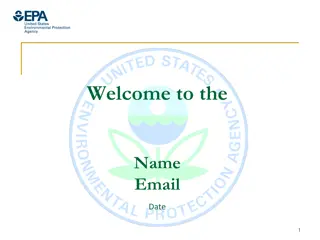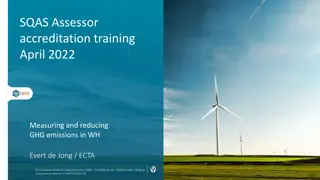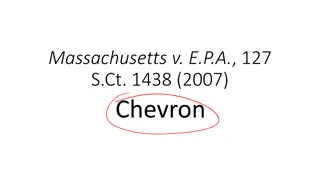Legal Battle Over EPA's Authority on Greenhouse Gas Regulation
The case of Massachusetts v. EPA revolves around a petition filed in 1999 requesting the EPA to regulate greenhouse gas emissions from new motor vehicles. Despite acknowledging its authority to regulate CO2 emissions, the EPA denied the petition in 2003, citing reasons related to the Clean Air Act. This decision led to a legal battle over the agency's role in addressing global climate change.
Download Presentation

Please find below an Image/Link to download the presentation.
The content on the website is provided AS IS for your information and personal use only. It may not be sold, licensed, or shared on other websites without obtaining consent from the author. Download presentation by click this link. If you encounter any issues during the download, it is possible that the publisher has removed the file from their server.
E N D
Presentation Transcript
What did the petition of October 20, 1999 ask the EPA to do? On October 20, 1999, a group of 19 private organizations filed a rulemaking petition asking EPA to regulate "greenhouse gas emissions from new motor vehicles under 202 of the Clean Air Act." As to EPA's statutory authority, the petition observed that the agency itself had already confirmed that it had the power to regulate carbon dioxide. What does the EPA have to do with a request? 3
What had the EPA said about its authority over CO2 in the past? In 1998, Jonathan Z. Cannon, then EPA's General Counsel, prepared a legal opinion concluding that "CO2 emissions are within the scope of EPA's authority to regulate," even as he recognized that EPA had so far declined to exercise that authority. Is CO2 regulated in other contexts? Where would CO2 pose an acute threat? Whose EPA was this? 4
Did EPA seek public comment on the petition? [45] Fifteen months after the petition's submission, EPA requested public comment on "all the issues raised in [the] petition," adding a "particular" request for comments on "any scientific, technical, legal, economic or other aspect of these issues that may be relevant to EPA's consideration of this petition." 66 Fed. Reg. 7486, 7487 (2001). 5
What was the response to the petition? On September 8, 2003, EPA entered an order denying the rulemaking petition. 68 Fed. Reg. 52922. The agency gave two reasons for its decision: (1) that contrary to the opinions of its former general counsels, the Clean Air Act does not authorize EPA to issue mandatory regulations to address global climate change, and (2) that even if the agency had the authority to set greenhouse gas emission standards, it would be unwise to do so at this time. 6
What is the Test for Constitutionally Required Standing? Lujan v. Defenders of Wildlife, 504 U.S. 555 (1992) Injury in fact Causation Redressability 8
Is this a Procedural Rights Case? In Lujan v. Defenders of Wildlife, the Court said, [t]he person who has been accorded a procedural right to protect his concrete interests can assert that right without meeting all the normal standards for redressability and immediacy." 9
Does Plaintiff in a procedural rights case have to show that the result would change? Sugar Cane Growers: "A [litigant] who alleges a deprivation of a procedural protection to which he is entitled never has to prove that if he had received the procedure the substantive result would have been altered. All that is necessary is to show that the procedural step was connected to the substantive result" Why is this going to be critical for a global warming case? 10
Do the same standing requirements apply to states as to individuals? " This is a suit by a State for an injury to it in its capacity of quasi-sovereign. In that capacity the State has an interest independent of and behind the titles of its citizens, in all the earth and air within its domain. It has the last word as to whether its mountains shall be stripped of their forests and its inhabitants shall breathe pure air." Justice Holmes explained in Georgia v. Tennessee Copper Co., 206 U. S. 230, 237 (1907) Did anyone notice this case in lower court litigation? Why not? 11
Injury to all is injury to none? "While it does not matter how many persons have been injured by the challenged action, the party bringing suit must show that the action injures him in a concrete and personal way. This requirement is not just an empty formality. It preserves the vitality of the adversarial process by assuring both that the parties before the court have an actual, as opposed to professed, stake in the outcome, and that the legal questions presented ... will be resolved, not in the rarified atmosphere of a debating society, but in a concrete factual context conducive to a realistic appreciation of the consequences of judicial action." 504 U. S., at 581 (Lujan) 12
Nature of the Injury Is global warming and ocean rise an injury to everyone? How do the projected effects in southern Louisiana different from those in west Texas? How do we use this to craft an argument that Massachusetts suffers an injury that is sufficiently individualized to justify standing? 13
What is the particularized injury that Mass claims to its own lands? Because the Commonwealth "owns a substantial portion of the state's coastal property," it has alleged a particularized injury in its capacity as a landowner. The severity of that injury will only increase over the course of the next century: If sea levels continue to rise as predicted, one Massachusetts official believes that a significant fraction of coastal property will be "either permanently lost through inundation or temporarily lost through periodic storm surge and flooding events." Sound familiar? 14
Redressability Assume that the EPA could reduce automobile exhaust emission to zero: Would this solve global warming? Can the US alone solve global warming? Why would accepting the EPA's argument in this case hurt agencies in other cases when they want to regulate something? Why does the court say small, incremental reforms are important? Is this even the right question in a procedural rights case? 15
Dissent - The State as Parens Patria As a general rule, we have held that while a State might assert a quasi-sovereign right as parens patriae "for the protection of its citizens, it is no part of its duty or power to enforce their rights in respect of their relations with the Federal Government. In that field it is the United States, and not the State, which represents them." Massachusetts v. Mellon, 262 U. S. 447, 485-486 (1923) 16
Is this a Political Question? What is the heart of the dissent's belief that this is a political question? Is there merit to this argument? Will US auto emissions standards affect global warming in a measurable, as opposed to theoretical way? Does this meet the traditional tests for redressability? This was a 5-4 case on standing - will it survive? The statutory interpretation question is more mainstream adlaw. 17
Background The Court has determined that the plaintiffs have standing. The court now addresses whether the agency was correct in finding that the Clean Air Act does not give it regulatory authority over green house gases from automobiles. 18
Chevron Analysis On Board
Stopped Here 20
The Chevron Test Step 1 Is the statute clear? Is the agency rule allowed/not allowed under the plain meaning of the statute? Step 2 If the statute is ambiguous, is the agency s rule based on a reasonable interpretation of the statute? Reasonable, not BEST this is the fight 21
What does the Clean Air Act 7521(a)(1) require the EPA to issue regulations on? [35] "The [EPA] Administrator shall by regulation prescribe (and from time to time revise) in accordance with the provisions of this section, standards applicable to the emission of any air pollutant from any class or classes of new motor vehicles or new motor vehicle engines, which in his judgment cause, or contribute to, air pollution which may reasonably be anticipated to endanger public health or welfare ... What other agency regulates autos? 22
What were EPA's two findings when it ruled on the petition in 2003? (1) that contrary to the opinions of its former general counsels, the Clean Air Act does not authorize EPA to issue mandatory regulations to address global climate change, see id., at 52925- 52929; and (2) that even if the agency had the authority to set greenhouse gas emission standards, it would be unwise to do so at this time. 23
What is the definition of pollutant in the act? [36] The Act defines "air pollutant" to include "any air pollution agent or combination of such agents, including any physical, chemical, biological, radioactive ... substance or matter which is emitted into or otherwise enters the ambient air." 7602(g). "Welfare" is also defined broadly: among other things, it includes "effects on ... weather ... and climate." 7602(h). Can you be a polluter under the law? 24
What was the EPA evidence of Congressional intent? [48] In concluding that it lacked statutory authority over greenhouse gases, EPA observed that Congress "was well aware of the global climate change issue when it last comprehensively amended the [Clean Air Act] in 1990," yet it declined to adopt a proposed amendment establishing binding emissions limitations. Id., at 52926. Congress instead chose to authorize further investigation into climate change. 25
Was there specific legislation on global atmospheric issues? EPA further reasoned that Congress' "specially tailored solutions to global atmospheric issues," 68 Fed. Reg. 52926 -- in particular, its 1990 enactment of a comprehensive scheme to regulate pollutants that depleted the ozone layer -- counseled against reading the general authorization of 202(a)(1) to confer regulatory authority over greenhouse gases. Is ozone the same issue as CO2? When does the specific rule out the general? 26
How was this position strengthened by the political history of the Clean Air Act? [50] EPA reasoned that climate change had its own "political history": Congress designed the original Clean Air Act to address local air pollutants rather than a substance that "is fairly consistent in its concentration throughout the world's atmosphere," declined in 1990 to enact proposed amendments to force EPA to set carbon dioxide emission standards for motor vehicles, ibid. and addressed global climate change in other legislation, 68 Fed. Reg. 52927. 27
Brown and Williamson v. FDA Can the FDA regulate tobacco? The Food and Drug Act defines as a drug as anything sold to affect the structure or function of the body . People use tobacco for the physiologic effect, thus it should be a drug, subject to regulation. Regulating tobacco under the Act might require banning it, because it is not safe for its intended use. The court found that the history of no regulation and the conflicts in regulation meant that the act did not apply. 28
Impact of Unilateral EPA Regs on Global Warming Treaties Why would motor vehicle regulations conflict with the goal of a comprehensive approach to global warming? Why would such regulations weaken the president's ability to persuade developing countries to lower their emissions? 29
Administrative Policy Rationale for the EPA Position What did EPA want from Congress before regulating green house gasses? What is the regulatory conflicts problem with the EPA regulating gasoline mileage? What does the EPA think of the association between global warming and human production of greenhouse gases? Is this really a technical decision? 30
What is the Evidence of Congressional Intent to Include Greenhouse Gases? 31
What was the National Climate Program Act of 1978? In 1978, Congress enacted the National Climate Program Act, 92 Stat. 601, which required the President to establish a program to "...assist the Nation and the world to understand and respond to natural and man-induced climate processes and their implications..." What does this tell us about concerns with greenhouse gasses (GHG) is it just something Al Gore thought up? 32
What did the National Academy of Sciences Tell President Carter? "If carbon dioxide continues to increase, the study group finds no reason to doubt that climate changes will result and no reason to believe that these changes will be negligible... . A wait-and-see policy may mean waiting until it is too late." 33
What did the Global Climate Protection Act of 1987 require the EPA to do? Finding that "manmade pollution -- the release of carbon dioxide, chlorofluorocarbons, methane, and other trace gases into the atmosphere -- may be producing a long- term and substantial increase in the average temperature on Earth," 1102(1), 101 Stat. 1408, Congress directed EPA to propose to Congress a "coordinated national policy on global climate change...Congress emphasized that "ongoing pollution and deforestation may be contributing now to an irreversible process" and that "[n]ecessary actions must be identified and implemented in time to protect the climate." Who was president in 1987? Is this really a liberal plot? 34
The First Global Warming Treaty What is the Kyoto Protocol? Why did the senate say it would reject it? Did it apply equally to all countries? What was Congress worried about? What is the potential economic consequence of the treaty for the US? Was this a partisan vote? Who was President? 35
What is the effect of this analysis? Does the court find that the EPA has the authority to regulate GHGs? What has to happen before it can exercise the authority? It must find that CO2 endangers the public health. Does it have the authority to not regulate CO2 if there is an endangerment finding? 36
